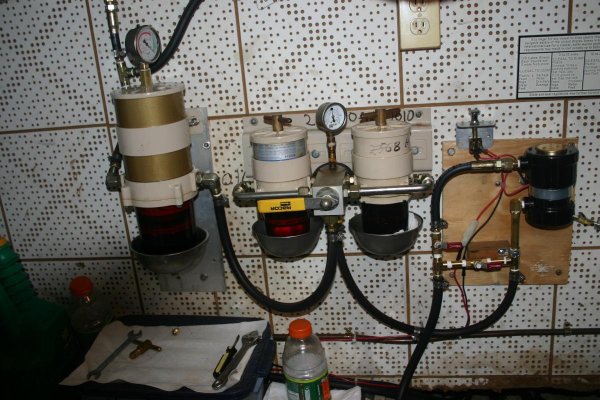Derik
Senior Member
- Joined
- Aug 21, 2018
- Messages
- 160
- Location
- United States
- Vessel Name
- Pearl Grace
- Vessel Make
- Marine Trader/Sun Deck 44
A few months ago I had a problem getting my starboard engine above 1500 RPM's and discovered the fuel filter was clogged. This was the Racor pre filter a 10 micron. So I put on a 30 micron on both raycor's and installed a Vacuum gauge on the starboard side thinking it was the bad side. I also added a Diesel Kleen to treat 300 gallons. I used the boat and no issues and the vacuum gauges on the starboard side is still green.
My plan was to run the boat for about 20 hours and then change all filters, and go back to a 10 on the pre filters so I only have to change them rather than the engine filters.
Friday when taking off the raycor on the Port side it was so bad that I was surprised the boat was running so well. The engine filters are hard to see but had some sediment in them as well. This was my first engine fuel filter change ever (new boat to me).
I have about 100 gallons left in each tank. My engines are Lehman 135's and the hours are low 1550 and 1650 but the boat was used frequently so I am told by my dock neighbors.
My questions are 1. will a raycor 30 micron last 3 times as long as a raycor 10 micron? 2. What are the chances the fuel is contaminated but the tanks are ok?
Has anyone had luck cleaning the fuel and not the tanks? They are original tanks fully wrapped in fiberglass. The price to do access hatches and fuel polishing was 2700.00.
My plan now is to do the starboard side with the new Raycor 10 micron and new engine filters. Clean both sediment bowls and flush. Check the fuel coming out of the tanks and if its ok leave it and keep changing pre filters and if it looks bad then drain all but 20 gallons or so from each tank take it to my house and set up a polisher or dispose of it.
My plan was to run the boat for about 20 hours and then change all filters, and go back to a 10 on the pre filters so I only have to change them rather than the engine filters.
Friday when taking off the raycor on the Port side it was so bad that I was surprised the boat was running so well. The engine filters are hard to see but had some sediment in them as well. This was my first engine fuel filter change ever (new boat to me).
I have about 100 gallons left in each tank. My engines are Lehman 135's and the hours are low 1550 and 1650 but the boat was used frequently so I am told by my dock neighbors.
My questions are 1. will a raycor 30 micron last 3 times as long as a raycor 10 micron? 2. What are the chances the fuel is contaminated but the tanks are ok?
Has anyone had luck cleaning the fuel and not the tanks? They are original tanks fully wrapped in fiberglass. The price to do access hatches and fuel polishing was 2700.00.
My plan now is to do the starboard side with the new Raycor 10 micron and new engine filters. Clean both sediment bowls and flush. Check the fuel coming out of the tanks and if its ok leave it and keep changing pre filters and if it looks bad then drain all but 20 gallons or so from each tank take it to my house and set up a polisher or dispose of it.

